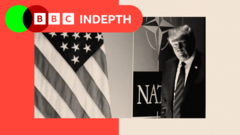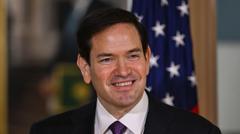As tensions rise in the Middle East, the potential for Iran to close the Strait of Hormuz sends ripples through the global economy, impacting oil prices and international trade.
**Strait of Hormuz: The Implications of a Potential Closure by Iran**

**Strait of Hormuz: The Implications of a Potential Closure by Iran**
An exploration of the global repercussions if Iran chooses to block the Strait of Hormuz, a critical oil transit route.
The Strait of Hormuz, a crucial artery for global oil trade, is teetering on the edge of geopolitical tensions. Approximately 20% of the world's oil and gas transit through this narrow maritime passage, making any disruption incredibly significant. With recent escalation in the US-Iran dynamics, particularly concerning nuclear facilities, speculation arises around the possibility of Iran retaliating by closing this vital corridor.
This strait, bordered by Iran to the north and Oman and the UAE to the south, is only about 50 kilometers wide at its entrances, with its narrowest point just 33 kilometers wide. This constriction makes it imperative for global oil supplies, as it facilitates the transit of crude oil from major producers such as Saudi Arabia, Iraq, and the UAE, alongside Iranian exports. Currently, around 20 million barrels of oil traverse the Strait of Hormuz each day, translating into nearly $600 billion annually in energy trade.
Former MI6 head, Sir Alex Younger, recently articulated the potential economic disaster surrounding a blockade of the Strait. Such an action could lead to skyrocketing oil prices, impacting the already fragile global economy. Bader Al-Saif, a geopolitics expert from Kuwait University, emphasized that stock markets would respond nervously to any moves made by Iran, with nations like China, India, and Japan being among the hardest hit due to their reliance on oil imports from the strait.
Despite the serious risks involved, closing the Strait is not a straightforward endeavor for Iran. Implementing a blockade would require deploying mines and small naval vessels to deter shipping, which poses its own risks. Military confrontations could ensue quickly, drawing in US forces given past precedents where the US intervened to ensure free navigation during conflicts in the late 1980s.
Historically, while Iran has issued threats to block the Strait, actual closure has never been executed. US Secretary of State Marco Rubio warned that such an act would be tantamount to "economic suicide" for Iran, urging allies like China to influence Tehran's decision-making process. Analysts suggest that while Iran may consider the strategy, the risks of alienating key trade partners and exacerbating regional tensions may outweigh potential benefits.
In response to ongoing threats to the Strait's operation, Gulf oil exporting countries have been proactive in developing alternative pipelines. Notably, Saudi Arabia has reactivated its East-West pipeline, capable of transporting significant volumes of crude oil. The United Arab Emirates has similarly taken steps to connect its oilfields to alternate ports, showcasing the lengths to which these nations are willing to go to circumvent potential disruptions.
As tensions mount in the Middle East, the global community watches closely, knowing that the fate of the Strait of Hormuz, a linchpin of the world’s energy supply, hangs in delicate balance.
This strait, bordered by Iran to the north and Oman and the UAE to the south, is only about 50 kilometers wide at its entrances, with its narrowest point just 33 kilometers wide. This constriction makes it imperative for global oil supplies, as it facilitates the transit of crude oil from major producers such as Saudi Arabia, Iraq, and the UAE, alongside Iranian exports. Currently, around 20 million barrels of oil traverse the Strait of Hormuz each day, translating into nearly $600 billion annually in energy trade.
Former MI6 head, Sir Alex Younger, recently articulated the potential economic disaster surrounding a blockade of the Strait. Such an action could lead to skyrocketing oil prices, impacting the already fragile global economy. Bader Al-Saif, a geopolitics expert from Kuwait University, emphasized that stock markets would respond nervously to any moves made by Iran, with nations like China, India, and Japan being among the hardest hit due to their reliance on oil imports from the strait.
Despite the serious risks involved, closing the Strait is not a straightforward endeavor for Iran. Implementing a blockade would require deploying mines and small naval vessels to deter shipping, which poses its own risks. Military confrontations could ensue quickly, drawing in US forces given past precedents where the US intervened to ensure free navigation during conflicts in the late 1980s.
Historically, while Iran has issued threats to block the Strait, actual closure has never been executed. US Secretary of State Marco Rubio warned that such an act would be tantamount to "economic suicide" for Iran, urging allies like China to influence Tehran's decision-making process. Analysts suggest that while Iran may consider the strategy, the risks of alienating key trade partners and exacerbating regional tensions may outweigh potential benefits.
In response to ongoing threats to the Strait's operation, Gulf oil exporting countries have been proactive in developing alternative pipelines. Notably, Saudi Arabia has reactivated its East-West pipeline, capable of transporting significant volumes of crude oil. The United Arab Emirates has similarly taken steps to connect its oilfields to alternate ports, showcasing the lengths to which these nations are willing to go to circumvent potential disruptions.
As tensions mount in the Middle East, the global community watches closely, knowing that the fate of the Strait of Hormuz, a linchpin of the world’s energy supply, hangs in delicate balance.























